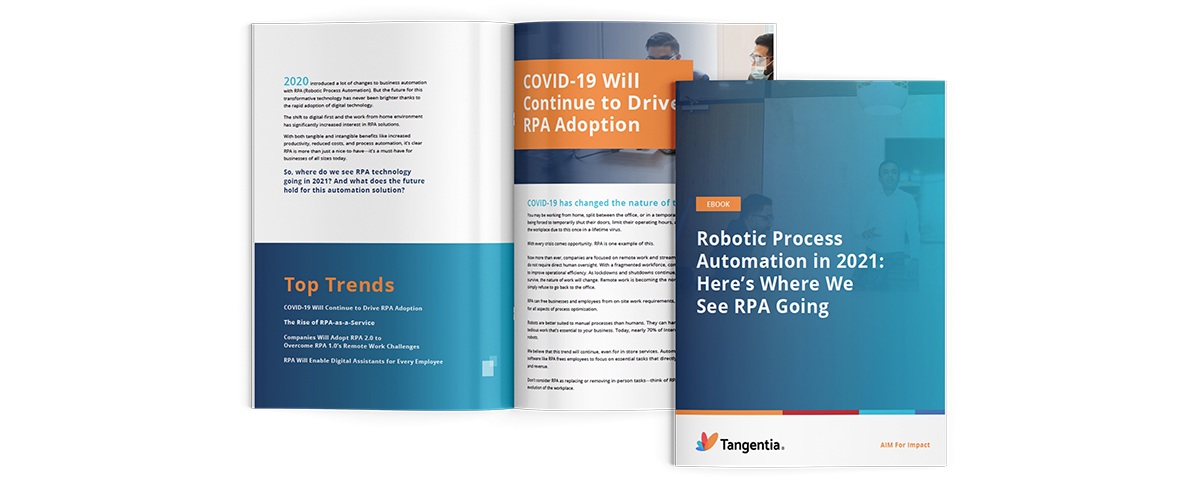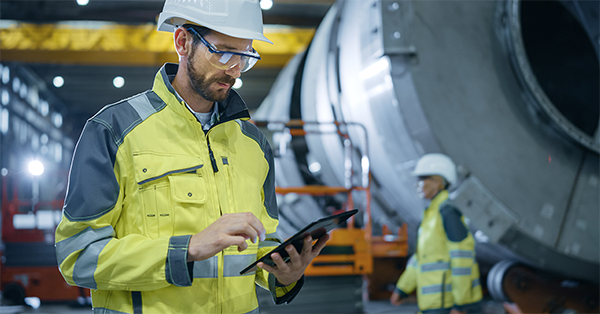What is Robotic Process Automation (RPA)?
Robotic process automation (RPA) is a set of tools and processes that are designed to automate digital processes. We work with companies of all sizes in a variety of industries to help them improve inefficiencies, automate tedious tasks, and drive more value out of their processes.
What does Robotic Process Automation (RPA) do?
RPA bots can be programmed to perform specific tasks like navigate systems, scan documents, identify and extract data and perform data entry. These are tasks that, when done by humans, take a long time to complete and are prone to error. RPA can complete these tasks in an error-free manner in just a fraction of the time.
What are the benefits of RPA?
The benefits of RPA in business operations and outcomes are many. Immediate benefits include lower costs, faster delivery and improved accuracy. But the benefits don’t stop there. Instead, the momentum of RPA benefits picks up pace and begins to affect all aspects of the organization.
Lower Costs
Of the people who participated in the Deloitte Global RPA Survey, 61% of them said RPA has already met or exceeded their expectations of cost reduction.
Integration Across Platforms
RPA is application-agnostic, meaning it doesn’t require a system upgrade and can seamlessly connect across all systems and software applications.
Increased Productivity
Deloitte reports that RPA increases overall productivity by as much as 86% by accelerating workflows and executing processes independently.
Improved Customer Experience
The use of RPA to automate front-office tasks has the power to improve the customer experience by as much as 50%.
Greater Accuracy
85% of the respondents in the Deloitte survey said that RPA met or exceeded their expectations when it came to accuracy, flexibility and timeliness.
Harness the Power of AI
Automation is enhanced when RPA is combined with the power of artificial intelligence (AI) to make use of unstructured data, understand intent and learn by performing tasks.
DOWNLOAD WHITEPAPER
The Future of Robotic Process Automation:
Here’s Where We See RPA Going
What transformative tasks can Robotic Process Automation (RPA) perform?
RPA focuses on high-volume, repetitive tasks that would take significant time when done manually.
- Logging into systems and applications
- Data entry
- Filling out forms
- Moving files and folders
- Performing data analysis
- Generating reports
The automation of these tasks frees up human workers to focus their time and energy on tasks that not only have more value for the organization, but are more meaningful for the individual. This results in happier employees and increased productivity, efficiency and innovation.
What is my RPA Journey?
IT leaders should be involved in the RPA planning and implementation process from the very beginning. Business and IT leaders must work together to determine how RPA can provide the most benefit for your organization. This involves developing a roadmap that helps you.
Once your roadmap is laid out, you can do a cost/benefit analysis and make your business case for the implementation of RPA. The important thing is to plan your RPA implementation well so you have a strong foundation for success.
- Establish a business case for RPA adoption and implementation
- Determine a timeframe for RPA implementation
- Identify the ideal model for RPA operations
- Determine an RPA governance plan
- Establish total cost of ownership
- Identify the end goal of RPA implementation
Click here for more information on getting started with RPA.
Where is RPA Being Used?
RPA can improve the customer experience, boost operational efficiency, ensure faster throughput and reduce error in a variety of industries.
Common RPA Use Cases
Leading companies are already leveraging the immense benefits RPA has to offer. See how these specific departments are using RPA to improve their operational efficiency from top to bottom:
What is RPA and how does it work?
RPA stands for Robotic Process Automation. RPA is a type of software that is programmed to perform repetitive computerized tasks in much the same way a human would. In this sense, “Robotic” refers to the software program, “Process” refers to the tasks being completed and “Automation” refers to setting up the program to run on its own.
What results can I expect from RPA implementation?
RPA removes the human element from performing repetitive tasks, freeing people up to focus on high-value tasks. This results in increased efficiency and productivity, lower costs, and consistency in terms of accuracy and overall quality.
What processes are the best fit for RPA?
RPA is best suited for processes that are consistent, repetitive, high-volume, time-consuming and do not require extensive human involvement. Thus, the tasks and processes well suited to RPA do not change over time, would take humans a long time to complete and involve a high risk of human error.
Examples of the types of tasks and processes suitable for RPA include cross-referencing data sources, pulling information from a variety of sources, and data entry and migration.
Where is RPA used?
RPA is freeing human workers to perform higher-value tasks in a number of industries, including manufacturing, banking and finance, insurance, retail, oil and gas, healthcare and automobile.












